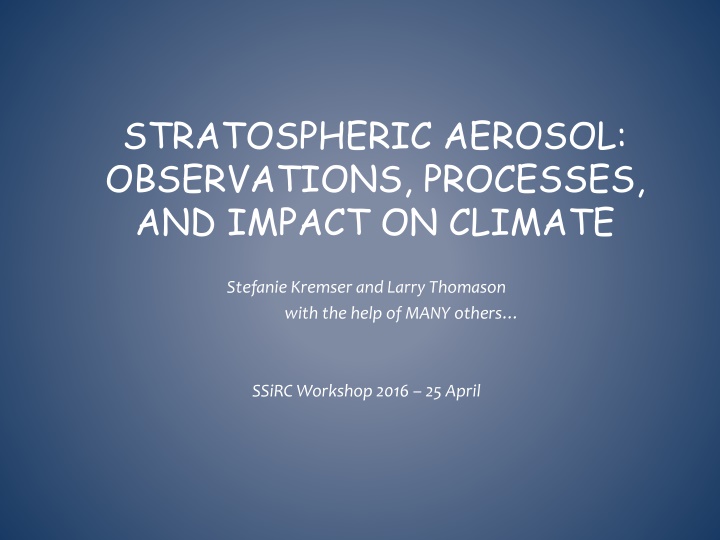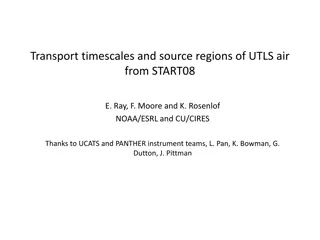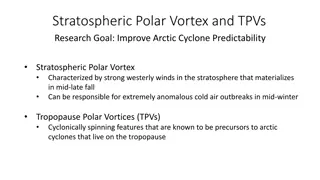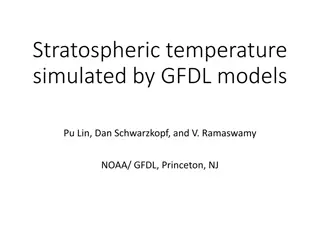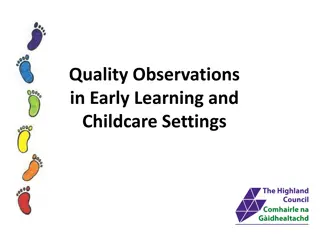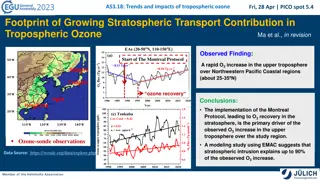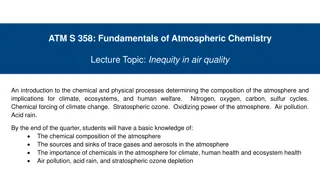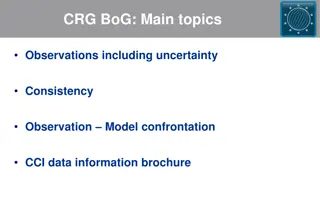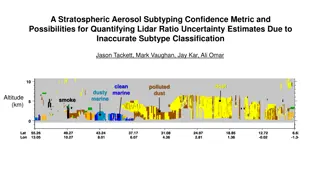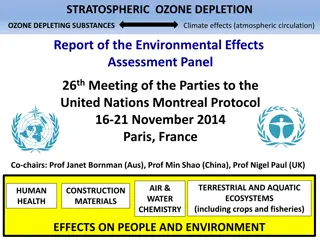STRATOSPHERIC AEROSOL: OBSERVATIONS, PROCESSES, AND IMPACT ON CLIMATE
The world of stratospheric aerosols, their role in climate, and the latest advancements in observation techniques and processes. Dive into the intricate details of aerosol life cycles and learn about the significant findings of studies spanning from 2006 to recent reviews. Uncover the differences in inferences of aerosol properties between in-situ and space-based measurements under volcanically quiescent conditions. Discover the net mass flux from the troposphere to the stratosphere during periods of volcanic quiescence. This comprehensive resource, authored by a team of experts in the field, provides a deep insight into this fascinating subject with a focus on climate impact."
Download Presentation

Please find below an Image/Link to download the presentation.
The content on the website is provided AS IS for your information and personal use only. It may not be sold, licensed, or shared on other websites without obtaining consent from the author.If you encounter any issues during the download, it is possible that the publisher has removed the file from their server.
You are allowed to download the files provided on this website for personal or commercial use, subject to the condition that they are used lawfully. All files are the property of their respective owners.
The content on the website is provided AS IS for your information and personal use only. It may not be sold, licensed, or shared on other websites without obtaining consent from the author.
E N D
Presentation Transcript
STRATOSPHERIC AEROSOL: OBSERVATIONS, PROCESSES, AND IMPACT ON CLIMATE Stefanie Kremser and Larry Thomason with the help of MANY others SSiRC Workshop 2016 25 April
STRATOSPHERIC AEROSOL: THE STUFF THAT DREAMS ARE MADE OF
CO-AUTHORS Larry W. Thomason Marc von Hobe Markus Hermann Terry Deshler Claudia Timmreck Matthew Toohey Andrea Stenke Joshua P. Schwarz Ralf Weigel Stephan Fueglistaler Fred J. Prata Jean-Paul Vernier Hans Schlager John E. Barnes Juan-Carlos Antu a-Marrero Duncan Fairlie Mathias Palm Emmanuel Mahieu Justus Notholt Markus Rex Christine Bingen Filip Vanhellemont Adam Bourassa John M. C. Plane Daniel Klocke Simon A. Carn Lieven Clarisse Thomas Trickl Ryan Neely Alexander D. James Landon Rieger James C. Wilson Brian Meland Thanks to the Editor Alan Robock and three anonymous reviewers
MOTIVATION Interest in stratospheric aerosol and its role in climate increased over last decade Last comprehensive assessment on stratospheric aerosol published in 2006 (SPARC ASAP report) New measurement systems and techniques developed for measuring physical aerosol properties with greater accuracy and for characterising aerosol composition Chemistry-climate models have substantially increased in quantity and sophistication
HIGHLIGHTS Stratospheric aerosol life cycle [SPARC, 2006] 90 0
HIGHLIGHTS Stratospheric aerosol life cycle first draft [Review, 2016]
HIGHLIGHTS Stratospheric aerosol life cycle [Review, 2016]
HIGHLIGHTS Differences between in situ and space-based inferences of stratospheric aerosol properties resolved (volcanically quiescence conditions) Surface area density Extinction 1 m SAGE SAGE = OPC SAGE 1.3 OPC factor of 2 2 OPC (balloon) OPC 3 1.5 SAGE SPARC, 2006 Review, 2016 Review, 2016 SPARC, 2006 Reasons: OPC: Better understanding of counting efficiency Reasons: OPC: Better understanding of counting efficiency SAGE: unchanged SAGE: Better understanding of the retrieval process
NET MASS FLUX Total net mass flux from the troposphere to the stratosphere of material that is eventually transformed into aerosol during volcanically quiescent periods SPARC, 2006 Sheng et al., 2015 Conflicting numbers: 820 t/d (precursor gases only) 718 t aerosol/d (Fig. 6.12; precursors only) 1450 t aerosol/d (incl. primary aerosol) 1152 t aerosol/d (precursors only) 2024 t aerosol/d (incl. primary aerosol) Net flux of precursors: 103 Gg S/year Net flux of precursors: 64.2 Gg S/year Net flux incl. primary aerosol: 181Gg S/year Talk by Terry Deshler and Tom Peter this week.
SOURCES OF STRATOSPHERIC AEROSOL - NONVOLCANIC Carbonyl sulfide (OCS) Volcanically quiescence - main contributor to stratospheric aerosol confirmed by model studies (Sheng et al., 2015, Bruehl et al., 2012) Large uncertainties in sources and sinks of OCS and consequently in the overall budget remain challenging to determine whether the OCS budget is currently closed or not. Sulfur dioxide (SO2) Transport of tropospheric SO2 second most important contributor Magnitude of anthropogenic SO2 emission to stratosphere aerosol and preferred pathway remain uncertain and subject to debate
SOURCES OF STRATOSPHERIC AEROSOL - VOLCANIC Annual flux of SO2 to the UTLS from volcanic eruptions varies greatly from year to year from <0.1 Tg to 24 Tg of SO2 emitted by volcanoes in the past 30 years. Average annual flux of SO2 from explosive volcanic eruptions: about 1.6 Tg to the UTLS, of which about 1 Tg enters the stratosphere (Carn et al. 2016). Scientific consensus that minor eruptions have non-negligible impact depending on location and injection height Further research required to determine role of SO2 injections into upper troposphere on stratospheric aerosol.
SOURCES OF STRATOSPHERIC AEROSOL - VOLCANIC
OBSERVATIONS OF STRATOSPHERIC AEROSOL Significant change in both instrument and techniques for measuring aerosol from space solar occultation replaced with limb and backscatter since early 2000s challenges to constructing consistent long-term stratospheric aerosol climatology
CLIMATE IMPACT Role in radiative balance of atmosphere reflecting solar shortwave radiation back to space and absorbing both longwave radiation emitted by the Earth and near-infrared solar radiation. Impact on climate assessed by climate model simulations Some models require prescribed stratospheric aerosol require offline forcing data sets as input Some data sets include ASAP 2006, CCMI 2012 and a CMIP6 2016 data set Later data sets are extended back to 1960 (CCMI) and 1850 (CMIP6) using a mix of models and ground-based observations
CLIMATE IMPACT Since 2006, significant increase in both quantity and sophistication of chemistry climate models improved representation of transport, sources and sinks of stratospheric aerosol SPARC [2006], only a few climate models where available now, at least 15 stratospheric aerosol-climate models are active A number of new model data intercomparison studies such as ISA-MIP and VolMIP Some models now coupled to radiation and/or stratospheric chemistry modules to account for relevant feedback processes
CURRENT STATUS - OUTCOME Review paper is key deliverable for SSiRC to SPARC Review paper accepted and currently finishing typesetting Paper: 58 pages with about 250 references Paper is getting some notice in EOS: Research Spotlight: https://eos.org/research-spotlights/decade-progress-stratospheric- aerosol-research Editors Vox: https://eos.org/editors-vox/blowin-in-the-wind-observing- stratospheric-aerosols Review paper online: http://onlinelibrary.wiley.com/doi/10.1002/2015RG000511/full
HIGHLIGHTS Differences between in situ and space-based inferences of stratospheric aerosol properties resolved (volcanically quiescence conditions)
